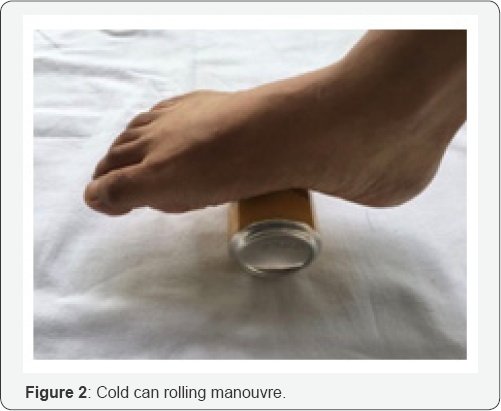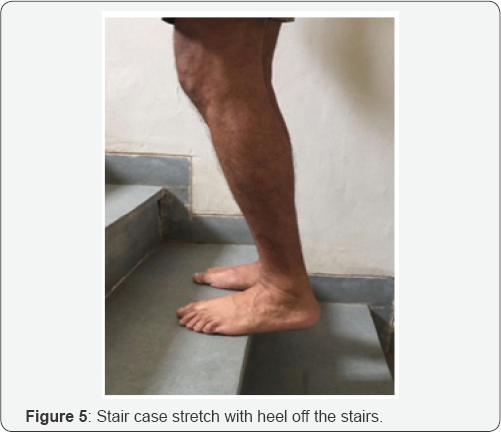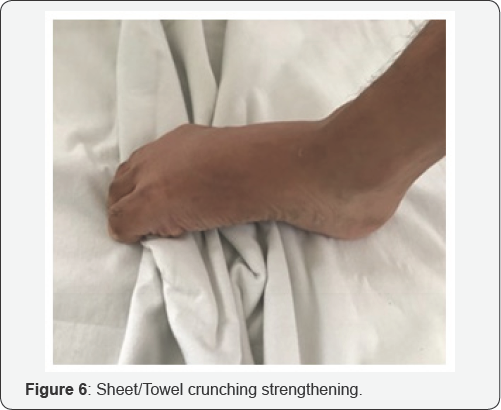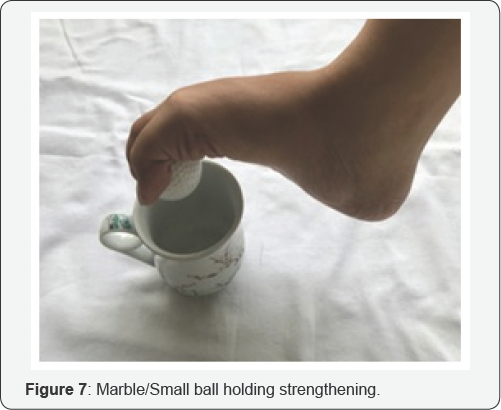Role of Exercises in Plantar Fasciitis
Amit Chauhan1* and Priyadarshini Sur2
1General Practice Trainee, Durham and Tees Valley GP Training Programme, UK
2Department of Medicine, Sharda Hospital, India
Submission: July 20, 2017; Published: July 25, 2017
*Corresponding author: Amit Chauhan, General Practice Trainee, Durham and Tees Valley GP Training Programme, UK, Tel: +447754748974; Email: amitcoolest4@gmail.com
How to cite this article: Amit C ,Priyadarshini S. Role of Exercises in Plantar Fasciitis. J Yoga & Physio. 2017; 2(2): 555581. DOI:10.19080/JYP.2017.02.555581
Abstract
Plantar fasciitis is a common entity amongst foot and ankle disorders. It is a clinical diagnosis and very rarely needs imaging modalities. It can be successfully treated with conservative management. Exercises form a major part of this conservative management. Authors would like to emphasise the role of different exercises in this condition to reduce morbidity and for successful activities of daily living.
Keywords: Plantar fasciitis; Exercises; Stretching; Conservative management
Abbreviations: NSAIDS: Non Steroidal Anti Inflammatory Drugs
Introduction
Plantar Fasciitis is a chronic degenerative process involving the plantar aponeurosis of the foot that is a cause of medial plantar heel pain. It is a common entity in primary care clinics all over the world. Anatomically, Plantar fascia consists of 3 bands of connective tissue which originates at the media tubercle of the calcaneum and inserts at the base of each proximal phalanx. When tensed during the terminal stance to toe-off phase of gait, plantar fascia elevates and reinforces the medial longitudinal arch allowing foot to function as rigid lever arm for forward propulsion [1,2]. Approximately 1 million visits to the primary physicians get the diagnosis of Plantar fasciitis each year [3]. It is more common in population aged 45-64 years and in women. A thorough history and musculoskeletal examination can clinch the diagnosis. Classical findings are medial plantar heel pain during weight bearing, intense pain during first few steps in the morning which relieves with rest, pain on palpation of medial plantar aspect of heel and with passive dorsiflexion of the toes and ankle. There are a few associated risk factors for this condition, namely flat/cavus feet, use of high heels, military personnel, long standing occupations, long-distance runners, obese and sedentary individuals [4,5]. This article would stress the different exercises recommended for plantar fasciitis which can bring great relief from morbidity of this condition.
These exercises can be divided into:
- Exercises to be done before getting out of bed
- Exercises to be done everyday
The role of stretching exercises which should be done before getting out of bed is mainly to reduce the heel pain which is experienced during first few steps. To start with, foot should be stretched by flexing it up and down a few times and holding it for 30 seconds. Plantar surface of the foot can be massaged gently as well. Toe stretches is another way for this purpose. Another effective way is to stretch the foot with the help of a towel. Stretching may cause some pulling sensation and many foot and ankle teams recommend taking a non-steroidal antiinflammatory drugs (NSAIDS) before doing these stretches, if needed.
There are a number of stretching and strengthening exercises which should be performed every single day. Toe stretch is done by stretching the great toe up and holding it up a few seconds. Towel stretch has been mentioned before and comes into these everyday exercises as well as shown in (Figure 1) [6]. Rolling the foot over a ball or a cold metal can and applying downwards pressure is another one in the stretching cohort (Figure 2). In addition to these, gastrocnemius and soleus stretch are other important exercises which take care of these strong muscles originating from above and below the knee respectively. For Gastrocnemius stretch, patient is asked to lean forwards with leg to be stretched placed behind keeping heel on the ground all the time (Figure 3). Stretch and hold for 30 seconds and repeat them in a few sets. Another way to perform this is to use a step and keep the heel dropped off it. Soleus is stretched by repeating the above manouvre but bending the back leg with heel again touching the ground at all times (Figure 4). Weight bearing on the toes with the heel off the stairs is also an effective way to stretch the plantar fascia (Figure 5). Strengthening exercises include crunching up a sheet or preferably a towel with the toes (Figure 6)and picking up marbles/small ball/pencil to strengthen the plantar fascia (Figure 7). These strengthening exercises are not required for the treatment of fasciitis but forms a continuum of the exercises after the stretching exercises.







Conclusion
Plantar fasciitis is a common condition diagnosed by primary care physicians and Foot/ankle specialist. It is a clinical diagnosis and does not need routine imaging. Imaging is rarely needed mainly to rule out other differential diagnosis. We have highlighted role of different exercises in this condition. Role of these exercises is based on the fact that 85-90% of patients with this condition can have successful outcome with conservative management [7]. These exercises forms the main part of a successful multimodal regime in addition to NSAIDS, orthosis, ultrasound, corticosteroid injections and extracorporeal shock wave therapy. Only when these measures including rest have been unsuccessful, surgery may be required. About 80% of patient treated with conservative management do not show any long term recurrence of pain (Riddle volume one).
References
- Gill LH (1997) Plantar fasciitis: diagnosis and conservative management. J Am Acad Orthop Surg 5(2): 109-117.
- Flanigan RM, Nawoczenski DA, Chen L, Wu H, Digiovanni BF (2007) The influence of foot position on stretching of the plantar fascia. Foot Ankle Int 28(7): 815-822.
- Riddle DL, Schappert SM (2004) Volume of ambulatory care visits and patterns of care for patients diagnosed with plantar fasciitis: a national study of medical doctors. Foot Ankle Int 25(5): 303-310.
- Owens BD, Wolf JM, Seelig AD, Jacobson IG, Boyko EJ (2013) Risk factors for lower extremity tendinopathies in military personnel. Orthop J Sports Med 1(1): 2325967113492707.
- Riddle DL, Pulisic M, Pidcoe P, Johnson RE (2003) Risk factors for plantar fasciitis: a matched case-control study. J Bone Joint Surg Am 85-A(5): 872-877.
- JF Sarwark (2010) Plantar Fasciitis. In: JF Sarwark (Ed.), Essentials of Musculoskeletal Care. (4th Edn), USA, pp. 839-844.
- Schepsis AA, Leach RE, Gorzyca J (1991) Plantar fasciitis: etiology, treatment, surgical results, and review of the literature. Clin Orthop Relat Res 266: 185-196.






























